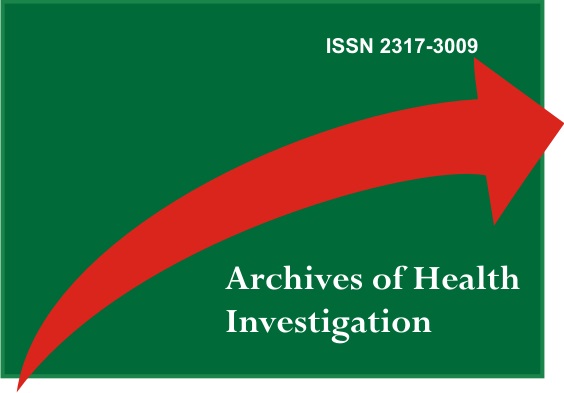Use of the ulectomy technique in Pediatric Dentistry to aid dental eruption: case report
DOI:
https://doi.org/10.21270/archi.v10i5.5089Keywords:
Pediatric Dentistry, Surgery, Oral, Tooth EruptionAbstract
Ulectomy is a surgical procedure that consists of removing the tissues that interrupt the tooth eruption. The present study proposes to report a clinical case of ulectomy in a pediatric patient in the tooth 22 region. An 8-year-old male patient attended the Odontopediatrics clinic at the University of Ribeirão Preto (UNAERP) for dental treatment. On intra-oral clinical examination, there was a volumetric increase in the buccal region of tooth 22 that had not yet erupted. The mother reported that the son did not present any type of trauma in that region. After radiographic examination, the presence of tooth 22 was observed, which was in an intraosseous position. Thus, ulectomy was indicated as a form of treatment because it is a simple and minimally invasive procedure. Due to the child not showing good behavior in the face of the clinical and radiographic examination, it was decided to initially perform conditioning sessions so that the surgical procedure could be performed next. After three weeks, surgery was performed. Initially, an elliptical incision was made, where it was possible to visualize the incisal region of tooth 22. Clinical follow-up was performed after 7, 15, 45 and 180 days, and it was possible to observe the eruption of tooth 22. In cases of dental impaction, there is the need to establish a relationship with its etiological factor for correct planning. It is concluded that the treatment provided provided aesthetic and phonetic improvement for the patient, as well as influenced the patient's social life.
Downloads
References
Kolokitha OE, Papadopoulou AK. Impaction and apical root angulation of the maxillary central incisors due to supernumerary teeth: Combined surgical and orthodontic treatment. Am J Orthod Dentofacial Orthop. 2008;134:153-60.
Enwonwu CO. Influence of socio-economic conditions on dental development in Nigerian children. Arch Oral Biol. 1973;18:95-107.
Singh N, Sharma S, Sikri V, Singh P. To study the average age of eruption of primary dentition in Amritsar an surrounding area. J Indian Dental Assoc. 2000;71:26.
Haddad AE, Correa MS. The relationship between the number of erupted primary teeth and the child’s height and weight: a cross-sectional study. J Clin Pediatr Dent. 2005;29:3357-362.
Holman DJ, Yamaguchi K. Longitudinal analysis of deciduous tooth emergence: IV – Covariate effects in Japanese children. Am J Phys Anthropol. 2005;126:352-58.
Bastos JL, Peres MA, Peres KG, Barros AJ. Infant grown, development and tooth emergence patterns: a longitudinal study from birth to 6 years of age. Arch Oral Biol. 2007;52:598-606.
Folayan M, Owotabe F, Adejuyigbe E, Sen S, Lawal B, Ndukwe K. The timing of the primary dentition in Nigerian children. Am J Phys Anthropol. 2007;134:443-48.
Oziegbe EO, Adenoyasofowora C, Folayan MO, Esan TA, Owotabe FJ. Relationship between sociodemographic and anthropometrics variables and number of erupted primary teeth in suburban Nigerian children. Matern Child Nutr. 2009;5:86-92.
Duarte MEQ, Andrade MA, Faria PC, Marques LS, Jorge MLR. Fatores associados à cronologia de erupção de dentes decíduos - Revisão de Literatura: Erupção de dentes decíduos e fatores associados. Rev Univ Vale do Rio Verde. 2011;9:139-51.
Huber K, Suri L, Parul T. Eruption Disturbances of the maxillary incisors: a literature review. J Clin Pediatr Dent. 2008;32:221-30.
Candeiro GTM, Correia FC, Candeiro SALM. Ulectomia como opção cirúrgica no retardo da erupção dentária: relato de caso. Rev Odontol Araçatuba. 2009;30:45-9.
Giglio FPM, Gurgel JA. Abordagem cirúrgico-ortodôntica de dentes não irrompidos. Ortodontia. 2010;43:169-75.
Arnaud RR, Santos MGC, Valença AMG, Forte FDS, Lima KJR, Beltão RTS. Ulotomia: coadjuvante do tratamento da má oclusão. RFO. 2014;19:234-38.
Pinkham JR, Casamassimo PS, Fields HW, McTigue DJ, Nowak A. Odontopediatria da Infância à Adolescência. São Paulo: Artes Médicas; 1996.
Guedes-Pinto AC. Odontopediatria. São Paulo: Santos; 2010.
Candeiro GTM, Correia FC, Candeiro SALM. Ulectomia como opção cirúrgica no retardo da erupção dentária: relato de caso. Rev Odontol Araçatuba. 2009;30:45-49.
Cavalcante AL, Paiva LCA. Utilização da ulectomia na clínica infantil: relato de caso. UEPG Ci Biol Saúde. 2006;12:39-42.
Biagi E, Butti AC. Premature loss of maxillary primary incisor and delayed eruption of its successor: Report of a case. Eur J Paediatr Dent. 2011;12:194-97.
Martinez JA, Mota LFG, Miranda IMAD, Guedes-Pinto AC. Cirurgia em odontopediatria. São Paulo: Artes Médicas; 1998.
Issao M, Guedes-Pinto AC. Manual de Odontopediatria. São Paulo: Pancast; 1994.
Poricelli E, Ponzoni D. Cirurgia bucal pediátrica. In: Toledo OA. Odontopediatria: fundamentos para a prática clínica. São Paulo: Premier; 2005.


